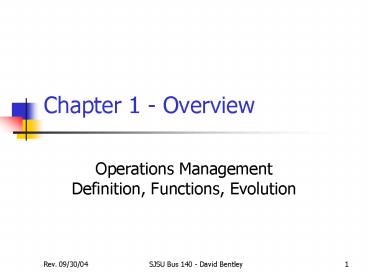Chapter 1 Overview - PowerPoint PPT Presentation
1 / 21
Title:
Chapter 1 Overview
Description:
Operations Management Definition, Functions, Evolution. Rev. 08/24/06. SJSU Bus ... U.S. capacity consumer demand money; women in the workplace; GI bill ... – PowerPoint PPT presentation
Number of Views:41
Avg rating:3.0/5.0
Title: Chapter 1 Overview
1
Chapter 1 - Overview
- Operations Management Definition, Functions,
Evolution
2
Definition Operations
3
Resources (Inputs)
- Material
- Labor
- Equipment
- Capital
- Land
- Buildings
- Technology
- Energy
- Knowledge
- Information
- Time
- Other?
4
Definition Management
- Activities involved in
- Planning
- Organizing
- Leading
- Controlling
- Other terms staffing, directing, etc.
- Directed to achieving organization goals
5
Definition Operations Management
- The value-added activities of planning,
organizing, leading, and controlling involved in
converting resources into goods and/or services.
6
Organizational Scope of OM
- Applies to all organizations
- Manufacturing
- Service (banks, insurance, health care)
- Wholesale retail
- Schools
- Religious institutions and charities
- Political parties, trade groups, unions
- Etc., etc., etc.
7
Primary Business Functions
8
OM Topics - 1
- Definition and evolution of OM
- Customers and competitiveness
- Strategy and productivity
- Quality management
- Types of operations (project, job, batch,
repetitive, continuous flow) - Product design
- Process planning and capacity management
9
OM Topics - 2
- Facility location and layout
- Work measurement
- Forecasting
- Inventory management
- Aggregate demand
10
OM Topics - 3
- Work scheduling
- Maintenance and reliability
- Supply chain management (including purchasing,
inventory control, MRP, lean operations JIT) - Project management
11
Why Study OM ?... because
- Its required for Business majors.
- It impacts us all
- It takes place in all organizations
- It reflects the rapidly changing world
- Many of you will be working directly in this area
- All managers need to possess some knowledge and
skills covered here
12
Evolution of OM pre-1400
- Ancient government, military, religious
- Pyramids, Great Wall, some trade
- Most business small, local, family
13
Evolution of OM 1400-1900
- Renaissance exploration, trade, banking,
manufacturing 1400-1700 - Division of labor (Adam Smith), interchangeable
parts (Eli Whitney), and the steam engine (James
Watt) 1700s - Transportation RR, steel and steamships 1800s
14
Evolution of OM 1900s - 1
- Scientific management (1900-1920)
- Frederick W. Taylor (1856-1915)
- Industrial engineer
- Father of Scientific Management
- Published The Principles of Scientific Management
in 1911 - ( Henry Gantt and Harrington Emerson)
15
Evolution of OM 1900s - 2
- Time and motion study
- Frank Lillian Gilbreth
- Assembly line and standardization
- Henry Ford
- Inventory management model
- F.W. Harris
16
Evolution of OM 1900s - 3
- Quality
- SPC Walter Shewhart,
- Acceptance Sampling H.G. Romig H.F. Dodge
17
Evolution of OM 1900s - 4
- Motivation
- Hawthorne studies Elton Mayo
- Hierarchy of needs Abraham Maslow, Frederick
Hertzberg - Theory X and Theory Y Douglas McGregor
- Theory Z William Ouchi
- Operations research various
18
Evolution of OM WW II
- Focus on output
- Post-war conditions of various countries
- U.S. capacity consumer demand money women
in the workplace GI bill - Changes in emphasis Production gt Mktg gt Cost
management gt Mergers Acquisition - Compare to Europe and Japan
19
Evolution of OM 1970
- Effects of Oil Embargo 1 and 2
- Role of Quality
- Understanding of Lean Operations (JIT)
- Recent trends
- See next slide
20
Recent Trends
- Global markets
- TQM
- Worker involvement
- Technology
- Reengineering
- Lean operations (JIT)
- Elimination of waste
- Customer satisfaction
- Shortening of time spans
- MRP II, ERP
- Extensive outsourcing
- Supply Chain Mgmt
- E-commerce B2C, B2B
- Internet brokering and application hosting
- Cost containment
- Business relocation
- Downsizing
21
Globalization issues - 2009
- Quality
- Communications
- Logistics
- Financial
- Legal
- Economic
- Cultural
- Sociological
- Political
- Theoretical































